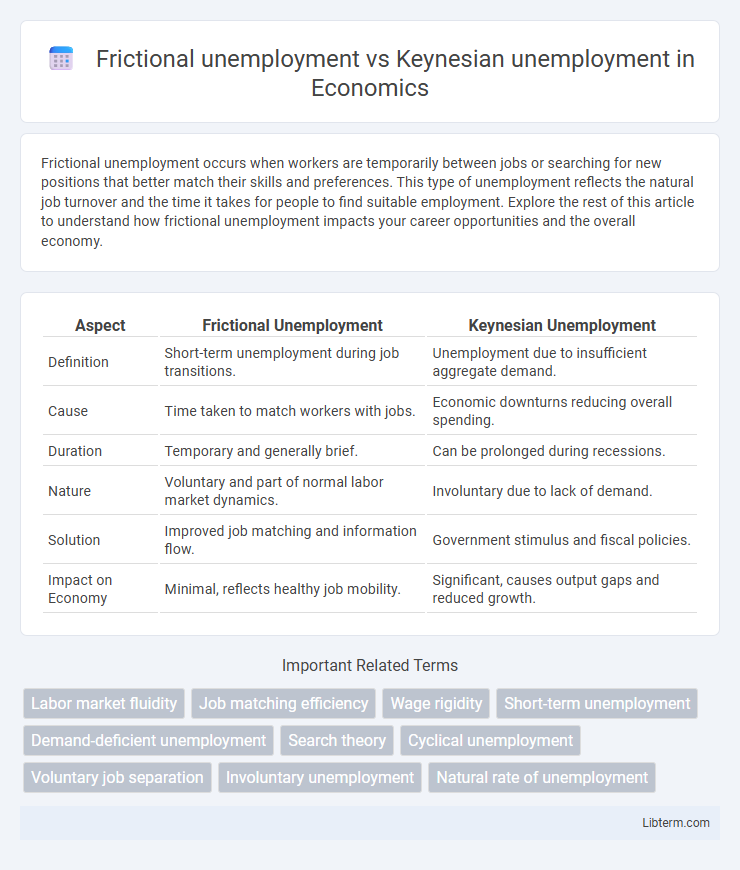Frictional unemployment occurs when workers are temporarily between jobs or searching for new positions that better match their skills and preferences. This type of unemployment reflects the natural job turnover and the time it takes for people to find suitable employment. Explore the rest of this article to understand how frictional unemployment impacts your career opportunities and the overall economy.
Table of Comparison
| Aspect | Frictional Unemployment | Keynesian Unemployment |
|---|---|---|
| Definition | Short-term unemployment during job transitions. | Unemployment due to insufficient aggregate demand. |
| Cause | Time taken to match workers with jobs. | Economic downturns reducing overall spending. |
| Duration | Temporary and generally brief. | Can be prolonged during recessions. |
| Nature | Voluntary and part of normal labor market dynamics. | Involuntary due to lack of demand. |
| Solution | Improved job matching and information flow. | Government stimulus and fiscal policies. |
| Impact on Economy | Minimal, reflects healthy job mobility. | Significant, causes output gaps and reduced growth. |
Understanding Frictional Unemployment
Frictional unemployment occurs when workers are temporarily between jobs as they search for positions that better match their skills or preferences, reflecting natural labor market turnover. Keynesian unemployment, by contrast, arises from insufficient aggregate demand, leading to prolonged joblessness even when workers are willing and able to work. Understanding frictional unemployment is crucial for analyzing short-term labor market dynamics and improving job matching efficiency through policies like job search assistance and labor market information systems.
Defining Keynesian Unemployment
Keynesian unemployment occurs when insufficient aggregate demand causes persistent joblessness despite available labor resources, reflecting a demand-driven deficiency in the economy. Frictional unemployment, in contrast, arises from temporary job transitions as workers search for better positions or enter the workforce for the first time. Understanding Keynesian unemployment involves recognizing the role of government fiscal policies and stimulus measures aimed at boosting demand to reduce cyclical joblessness.
Key Differences: Frictional vs Keynesian Unemployment
Frictional unemployment occurs due to the time workers spend searching for new jobs or transitioning between roles, reflecting a healthy dynamic labor market. Keynesian unemployment arises from insufficient aggregate demand causing prolonged joblessness during economic downturns, driven by macroeconomic factors. Frictional unemployment is typically short-term and voluntary, while Keynesian unemployment is often involuntary and linked to cyclical economic fluctuations.
Causes of Frictional Unemployment
Frictional unemployment arises primarily from the time it takes for workers to search for new jobs that better match their skills, preferences, or locations, reflecting natural labor market turnover. It is caused by imperfect information, changes in demand for different types of jobs, and voluntary job transitions due to career changes or geographic moves. Unlike Keynesian unemployment, which stems from insufficient aggregate demand, frictional unemployment is considered short-term and inevitable in dynamic economies.
Root Causes of Keynesian Unemployment
Keynesian unemployment primarily stems from insufficient aggregate demand in the economy, leading to a prolonged lack of job creation despite available labor supply. Unlike frictional unemployment, which arises from temporary mismatches in the labor market during job transitions, Keynesian unemployment reflects systemic demand shortfalls that reduce business revenues and investment. Central banks and governments often address this through fiscal stimulus or monetary policies aimed at boosting consumption and investment to close the demand gap.
Economic Impact of Frictional Unemployment
Frictional unemployment, characterized by short-term job transitions as workers search for new opportunities, typically has a limited negative economic impact compared to Keynesian unemployment, which stems from insufficient demand in the economy. The economic impact of frictional unemployment includes manageable productivity losses and wage adjustments, as it often reflects healthy labor market dynamics and worker mobility. Policymakers view frictional unemployment as a natural and even beneficial process, supporting efficient job matches and long-term economic growth.
Economic Impact of Keynesian Unemployment
Keynesian unemployment, driven by insufficient aggregate demand, leads to prolonged economic downturns and persistent resource underutilization, exacerbating GDP gaps and reducing overall economic output. This type of unemployment increases government expenditure on social welfare programs and unemployment benefits, straining public finances and potentially leading to higher deficits. Unlike frictional unemployment, which is short-term and facilitates labor market mobility, Keynesian unemployment causes significant negative multiplier effects, slowing recovery and hindering economic growth.
Policy Responses for Frictional Unemployment
Policy responses for frictional unemployment emphasize improving job matching efficiency through enhanced labor market information systems, job search assistance programs, and vocational training. Governments invest in unemployment benefits with active job search requirements to minimize the duration of frictional unemployment. Unlike Keynesian unemployment policies targeting demand stimulation, frictional unemployment policies focus on reducing job search frictions and accelerating workforce mobility.
Keynesian Solutions to Unemployment
Keynesian unemployment arises from insufficient aggregate demand causing prolonged joblessness, unlike frictional unemployment, which is due to normal labor market turnover. Keynesian solutions emphasize government intervention through fiscal policies, including increased public spending and tax cuts, to stimulate demand and create jobs. Monetary policy, such as lowering interest rates, also plays a crucial role in encouraging investment and reducing unemployment under Keynesian economics.
Comparative Analysis: Frictional and Keynesian Unemployment
Frictional unemployment occurs when workers are temporarily between jobs or searching for new ones, reflecting natural labor market turnover and job matching processes. Keynesian unemployment arises from insufficient aggregate demand, leading to prolonged periods of unemployment due to economic downturns and reduced consumer spending. Comparing the two, frictional unemployment is generally short-term and voluntary, while Keynesian unemployment is demand-deficient and often requires fiscal or monetary policy intervention to stimulate economic activity.
Frictional unemployment Infographic

 libterm.com
libterm.com